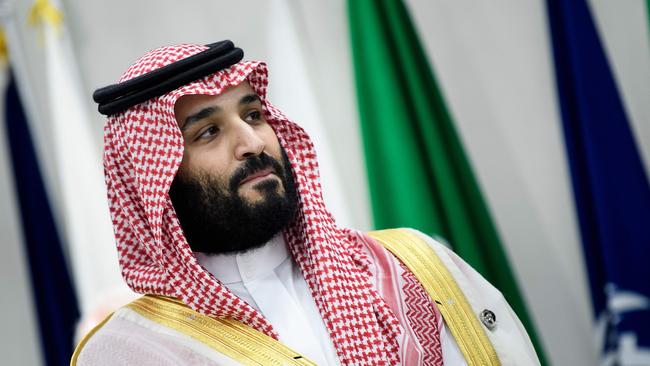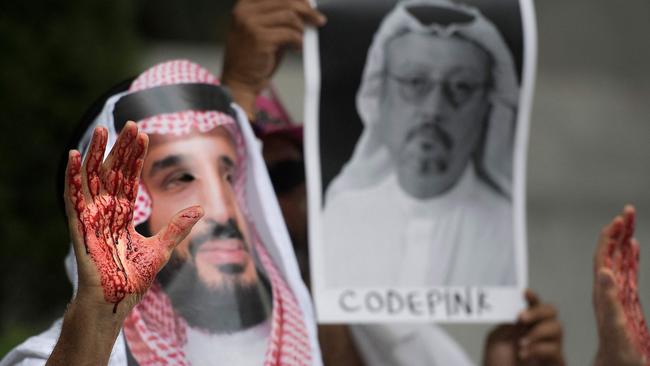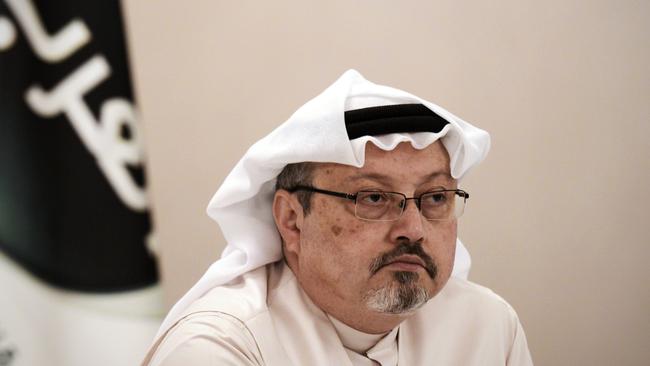Saudi crown prince approved Khashoggi ‘kill or capture’
Biden administration declassifies stunning CIA report suppressed by Trump blaming Saudi crown prince for Jamal Khashoggi’s murder.

The Biden administration has declassified an explosive CIA report suppressed by President Trump that blames Saudi Arabia’s powerful crown prince for the murder of the dissident journalist Jamal Khashoggi.
Its publication was the latest in a flurry of moves over the past two days that rebalanced America’s Middle East policy by intensifying diplomatic pressure on Riyadh while attacking militants backed by the kingdom’s chief regional rival, Iran.
The three-page summary includes the conclusion that “Saudi Arabia’s Crown Prince Mohammed bin Salman approved an operation in Istanbul, Turkey to capture or kill Saudi journalist Jamal Khashoggi” in 2018.
It names 21 additional individuals including seven members of the crown prince’s personal protective detail who “participated in, ordered, or were otherwise complicit in or responsible for the death of Jamal Khashoggi on behalf of Mohammed bin Salman”. Khashoggi, 59, was based in the US and wrote for The Washington Post.
The crown prince, 35, is the king’s son and heir to the throne with “absolute control of the kingdom’s security and intelligence organisations,” according to the report.

The release of the CIA report was authorised by President Biden after it was blocked by Trump, who embraced Saudi Arabia’s rulers as a regional counterweight to Iran and lucrative source of arms sale revenue.
On Thursday Biden, 78, ordered the first military action of his White House tenure, hitting Iranian-linked fighters in eastern Syria in retaliation for rocket attacks against American targets in neighbouring Iraq.
Hours earlier the president spoke for the first time to King Salman of Saudi Arabia, 85, reiterating that the United States would no longer support its war in Yemen against the Iranian-backed Houthi rebel movement and underlining the “importance the US places on universal human rights and the rule of law”.
Meanwhile it was reported last night that the Biden administration was shifting its weapons sales policy to limit arms purchases by Riyadh to “defensive” military equipment only.
During the presidential election campaign Biden pledged to make Saudi Arabia “pay the price” for the bloody escalation of its war in Yemen by ending weapons sales “and make them in fact the pariah that they are” for the Khashoggi murder.
Biden has repeatedly used the word “recalibrate” to define his approach to the Middle East.
The shift away from Saudi Arabia is “pretty dramatic,” David Rundell, a former US chief of mission in Riyadh, told Axios this week. “To be honest, I find it all rather dangerous.”
Biden wants to pacify the region so that the US can switch diplomatic focus to Russia and China. That will hinge on bringing Iran in from the cold.

As vice-president between 2009 and 2017 Biden saw first hand how an earlier effort to deploy that strategy played out under President Obama. The White House secured the 2015 nuclear deal with Iran, which Trump tore up three years later, but it also alienated allies such as Israel and Saudi Arabia. Obama’s determination to influence events in Syria and elsewhere in the Middle East without intervening militarily ended up with the even greater conflagration of the civil war in Syria and the fight to defeat Islamic State.
That has led to the chaos in eastern Syria. US-backed Kurdish-led forces operate there, with regime forces to the west and another US-backed force of former Syrian Arab rebels holding an area to the south near the border with Jordan. Iranian-backed militias are also embedding themselves there.
The air strikes on Thursday night were against militias in the eastern Syrian province of Deir Ezzor and were intended as a signal that while Biden plans to revert to Obama’s strategy of negotiation with Iran, ending Trump’s attempt to isolate the regime in Tehran, he will do so within the historic norms of asserting US military might.
The Pentagon said the bases targeted were being used by the same militias, belonging to Iraqi Shia paramilitary forces aligned to Iran, that were implicated in a rocket attack on a base in Arbil, in Kurdish northern Iraq, this month. That attack killed two civilian contractors and wounded several people including a US serviceman.
Lloyd Austin, Biden’s newly appointed defence secretary, said: “We’re confident that that target was being used by the same Shia militants that conducted the strikes.”
Critics had accused Biden of weakness in the face of Iranian provocation for not responding immediately as Trump had in December 2019 after an Iraqi-American translator was killed in a militia attack.

But Austin added: “We said a number of times that we will respond on our timeline. We wanted to be sure of the connectivity and we wanted to be sure that we had the right targets.”
John Kirby, a Pentagon spokesman, said: “The operation sends an unambiguous message: President Biden will act to protect American and coalition personnel.”
According to unconfirmed reports the scale of the US response was mild compared with Trump’s strikes in the same area in 2019. They said that on this occasion seven 500lb bombs were dropped on a series of command posts and three trucks carrying ammunition across the border from Iraq.
Kataeb Hezbollah said one of its fighters had been “martyred”, though the Syrian Observatory for Human Rights, a monitor, said it had been told that the total figure was 22 dead. Russia condemned the strikes as a violation of Syrian sovereignty.
The strikes received support from Republicans in Washington but were questioned by some Democrats.
Middle East experts interpreted the attack partly as a negotiating chip before talks with Iran. “The strike . . . was meant to set the tone with Tehran and dent its inflated confidence ahead of negotiations,” Bilal Saab, a former Pentagon official who is a senior fellow at the Middle East Institute, told The Washington Post. “You don’t want to enter into potential talks with Iran on any issue with a bruise to your face from the Arbil attacks.”
Q&A
What will Biden do next?
There is no sign of him backing away from his keynote foreign policy plans for the region - to engage with Iran over its nuclear programme and distance himself from MBS. His first airstrikes seem to be trying to show he will argue with Iran from a position of strength. He has offered to rejoin nuclear talks but will not lift sanctions until it stops breaching the limits set by the deal.
What did the US attack?
The far eastern parts of Syria , to the east and west of the Euphrates, have become a haven for proxy militias after falling out of the control of the Assad regime. Large parts are run by the US-backed Kurdish-led army known as the Syrian Democratic Forces. Elsewhere, the regime is in notional charge but militias loyal to Iran have a strong presence. Al-Bukamal, a town on the Iraqi border is a key crossing point for militias, part of a long axis of Iranian influence stretching from Tehran , across central Iraq and Syria, to Hezbollah-run parts of Lebanon. The US hit sites near al-Bukamal associated with two Iranian-backed militias, Kataeb Hezbollah and Kataeb Sayyid al-Shuhada.
If Biden was retaliating for a rocket strike on a US base in Iraq, why did he strike Syria?
The two militias concerned are Iraqi Shia forces that Iran is using for its purposes inside Syria. Both are part of a coalition of paramilitary forces operating inside Iraq, the Popular Mobilisation Units. They joined forces with the US and its allies in driving back Islamic State from 2014 to 2018, but since then have turned on the coalition. The US believes these Shia militias were responsible for an attack this month on the US base in Arbil, in Kurdish northern Iraq, albeit operating behind a new front group called Saraya Awliya al-Dam. Biden may have decided to strike in Syria not Iraq as his diplomats in Baghdad are involved in talks to maintain a US presence to balance Iranian interests.
Wasn’t Biden ending the “forever wars"?
He has signalled he wants to withdraw from messy Middle East conflicts, which occupy so much time and military force. But so did Barack Obama and Donald Trump, and US doctrine insists the military should not show weakness. The US looks likely to maintain a presence in Iraq and eastern Syria. Those forces will almost certainly continue to defend themselves.
Do US presidents always bomb the Middle East?
The last US president not to order strikes on an Arab country was Jimmy Carter. Ronald Reagan bombed or shelled Lebanon and Libya, George Bush Sr, Bill Clinton and George W Bush all bombed Iraq, while Obama, whose determination to make peace in the region won him the Nobel prize, ended up striking not only Iraq but Libya, Yemen and Syria too.



To join the conversation, please log in. Don't have an account? Register
Join the conversation, you are commenting as Logout